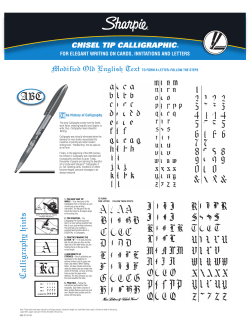
GET STARTED WITH CALLIGRAPHY
GET STARTED WITH CALLIGRAPHY Scribes developed calligraphy, the ancient art of beautiful writing, long before print existed. Today, in our modern era of visual communications, it’s a skill that’s ever more relevant. Here are some top tips and resources from the Cathedral’s chief scribe to help you get started. What is calligraphy? The term calligraphy comes from the Greek words for beautiful (kalos) and writing or drawing (graphos). It means creating well-made letters and shapes by hand, normally with special pens or quills, paints and ink, and arranging them beautifully. The modern revival of calligraphy is credited to the English scribe Edward Johnston, working in the late 19th century. He was encouraged to study calligraphy by the artist and thinker William Morris, who had experimented with writing out books in a medieval style. Johnston began studying early manuscripts and rediscovered the use of the broad-edged pen and how letters were made with it. He went on to create the Foundation Hand – the basis of modern calligraphic practice. It’s an exciting and absorbing skill to learn, and it’s a lot easier to get started than you think. The possibilities for creating new shapes, ideas and images are endless. Top tips Get to know your pen. Spend time with it in your hand, making different kinds of strokes and movements, and finding the most comfortable way to hold it. Practise regularly. Set aside time to do regular exercises, so that you can see your progress. Master one alphabet. Start by studying just one alphabet, rather than trying to master lots of different kinds of lettering. You want to get to the point where you can write in your chosen alphabet without having to check back to or copy from a book. Set yourself a goal. Decide on some kind of end product you want to create – perhaps a piece of text to frame or a card for a special occasion. Having a goal in mind will help motivate you and push you onwards. Use appropriate tools. Don’t try to work with poor quality equipment. Get yourself set up with the right tools for the job, and lay them out in an orderly way before you start work. See below. What kinds of equipment will I need? A selection of pens – these range from traditional nib pens dipped in ink, to calligraphy pens with builtin cartridges. You can also use felt-tip pens although these cannot produce angled lines. Good-quality paper – you’ll need a fine, absorbent, smooth surface to work on if you’re to produce clean lines. A4 and A3 pads of layout paper will do fine – and they’re also economical! A sloping board – if you rig up your own surface, make sure it’s firmly anchored. Or you may want to invest in a proper desk-top easel [check] Calligraphy ink – this is usually water-based and much less viscous than the oil-based inks used in printing. A ‘T’-square – this simple piece of equipment will prove invaluable in helping you lay out and check the alignment of your work Paints – you’ll need watercolour paints for colouring and decorating your work, and it’s also useful to have gouache paint, which is more opaque and reflective than watercolour paint. 1 GET STARTED WITH CALLIGRAPHY How can I get involved? Winchester Cathedral has a team of up to 20 modern-day volunteer scribes, the largest of its kind in any English cathedral today. They work from a Scribes’ Desk based in the Cathedral, producing original work ranging from prayer cards to a while-you-wait calligraphy service for items such as bookmarks. Our calligraphy workshops start with teaching the Foundation Hand, and are open to people of all ages and levels of experience. If you’d like to find out more about taking part, please email calligraphy@winchestercathedral. org.uk Recommended resources A Beginner's Guide to Calligraphy: A Three-Stage Guide to Mastering the Skills of Letter Art Mary Noble and Janet Mehigan 2007, paperback, £12.99 Calligraphy Made Easy Gaynor Goffe 1996, paperback, £31.87 Step By Step Calligraphy: A Complete Guide with Creative Projects Sue Hufton 1997, paperback Calligraphy (Easel Does it) Nancy Ouchida-Howells 2004, spiral bound, £16.99 Produced by: Phillip Johnson, Calligraphers Section Head Date: March 2011 2
© Copyright 2025





















